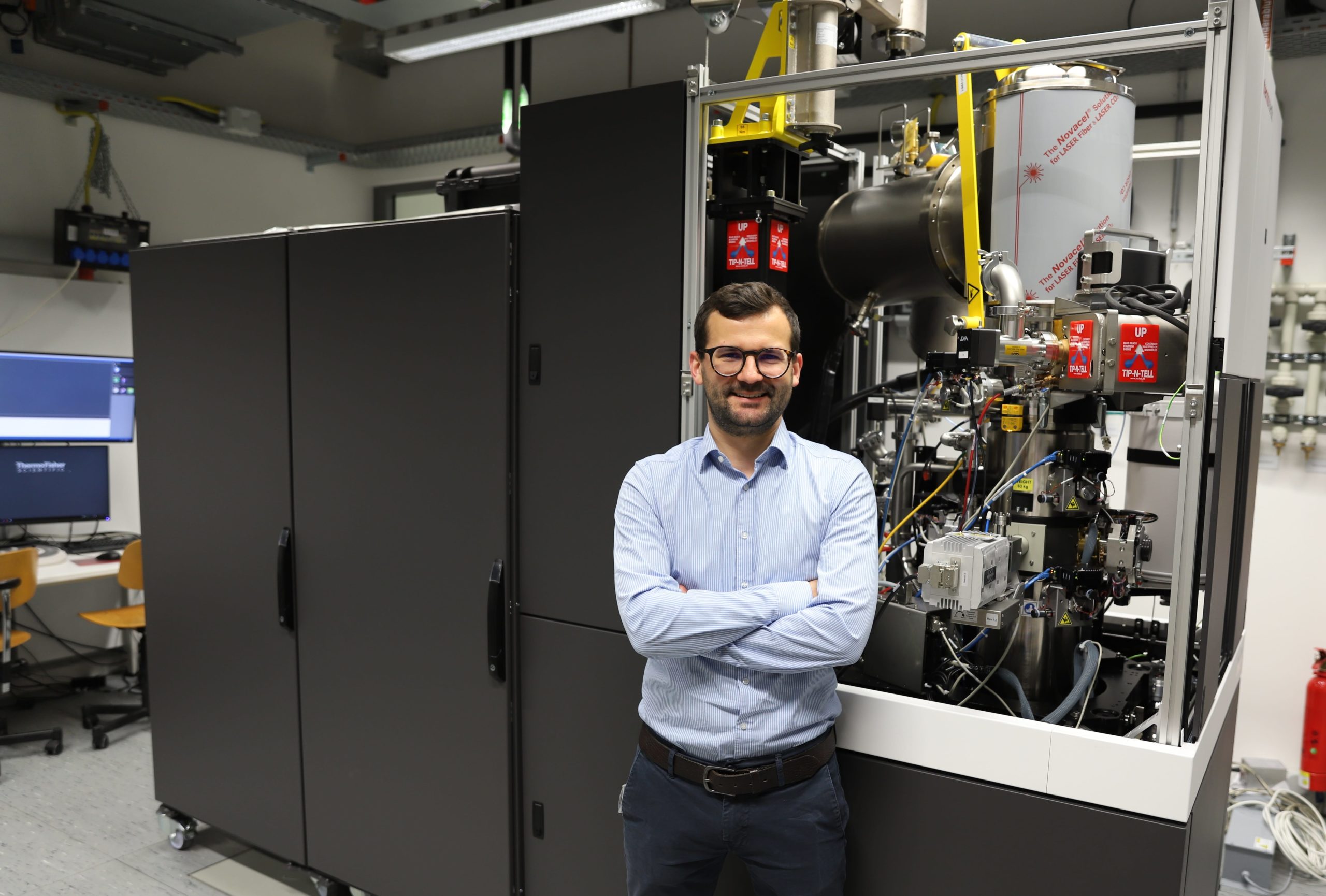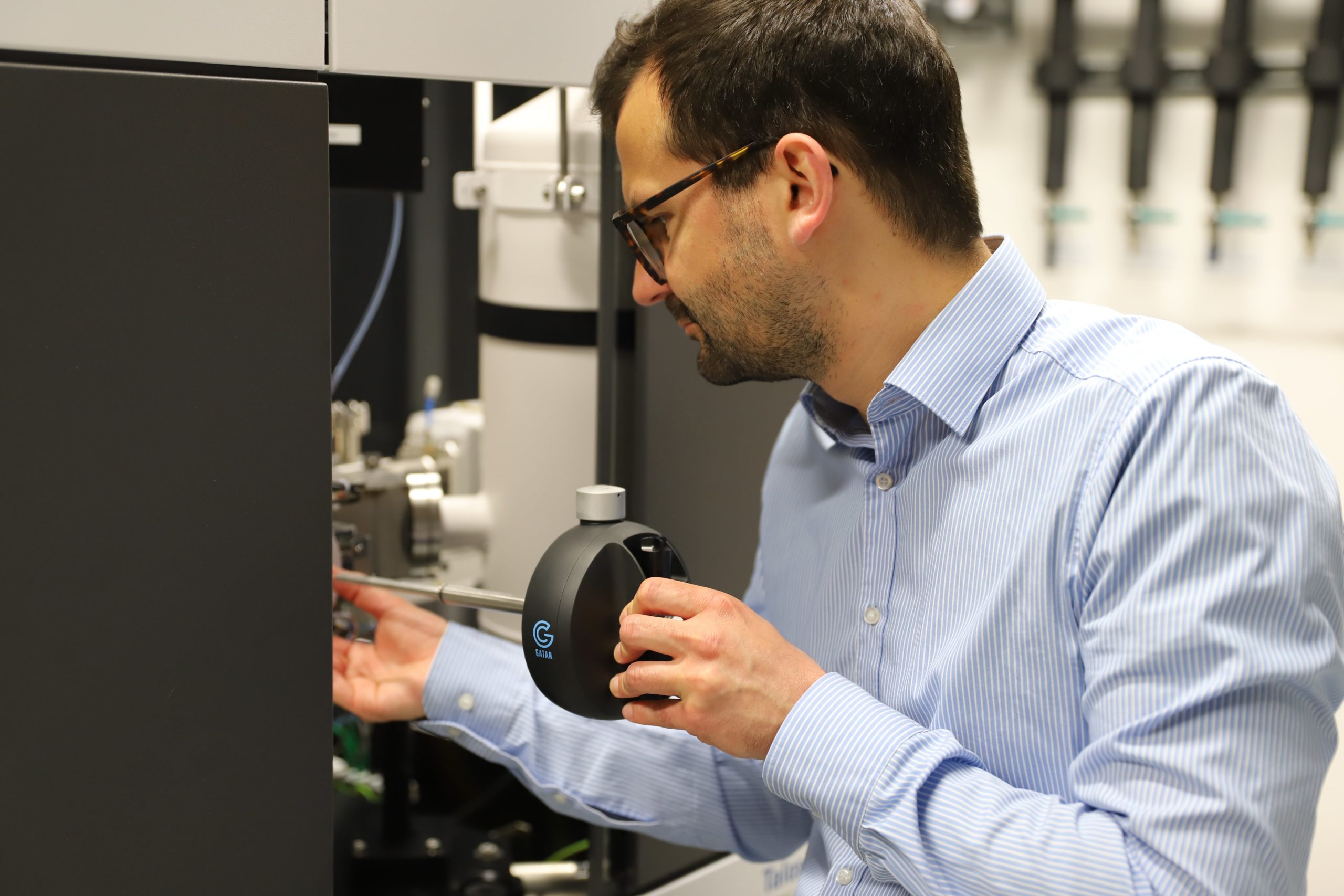May 24th, 2023
The HIU put its own transmission electron microscope (TEM) into operation in May. These microscopes are typically used to image thin samples at very high resolution. An electron beam with a high acceleration voltage is focused onto the sample from above. A detector placed under the sample registers the transmitted electrons. From this, conclusions can be drawn about the interaction between the electrons and the sample. The researchers receive very local information about the material.
Dr. Simon Fleischmann and his research group “Electrochemical Interfaces in Nanoconfinement” are responsible for the new device. We ask him for device details.
Dr. Fleischmann, can you give us some technical data on the TEM at the HIU?
Dr. Fleischmann: The device is equipped with a so-called “high brightness” Schottky field emission cathode with an acceleration voltage of 200 kV. The emitted electrons have an energy of 200,000 eV with an energy resolution of 1 eV, i.e. the electron energy deviates by at most 1 eV. This enables a very high resolution of just over 1 angstrom, which roughly corresponds to the bond length of atoms, to be achieved. The microscope is also equipped with two large area detectors for energy dispersive X-ray spectroscopy (EDX) and one detector for electron energy loss spectroscopy (EELS).

Photo: New Transmission Electron Microscope at HIU.
How does the device help you in research?
Dr. Fleischmann: Many of our conventional examination methods give us statistical information about the entirety of a sample, but we do not know what the sample looks like at a specific point, for example. In contrast to this, the TEM can be used to obtain structural and chemical information with an extremely high spatial resolution; one can, so to speak, look at the local environment of individual atoms at a particularly interesting point on the sample. It should also be emphasized that the TEM can not only “image”, but also diffraction and spectroscopy can be carried out with a similar spatial resolution.
Scientists at HIU put a ? transmission electron microscope (#TEM) into operation. For technical data, check our interview with @SFleischmann_ whose group will train ? researchers working with the device. @KITKarlsruhe @CELEST_18 @ClusterPolis @uni_ulm https://t.co/c7T8qBi4rd
— Helmholtz Institute Ulm ???? (@HelmholtzUlm) May 24, 2023
Which special materials (for which applications?) do you research with the TEM?
Dr. Fleischmann: We will mainly use the TEM for the investigation of novel electrode or solid electrolyte materials with unknown local structure as well as for interface characterization in electrochemical systems. A great deal of knowledge can be gained if, for example, one understands where and how ions or molecules are incorporated into a crystalline electrode material, or if one obtains highly localized information about interfaces and interphases that have arisen during electrochemical operation on electrode surfaces. So we are talking specifically about structure elucidation of materials with engineered crystal structure, e.g. my group’s “nanoconfinement materials”, solid electrolytes, and the exploration of interphases like the “solid electrolyte interphase” (SEI).
In these investigations, I would also like to highlight the specially purchased sample holders (so-called cryo holders), which “freeze” these highly sensitive and reactive samples with liquid nitrogen during the measurement. As a result, damage to the sample during measurement can be largely avoided and the original structure can be studied.

Photo: Inserting the TEM sample holder. This has a liquid nitrogen tank (“dewar”), which cools the sample during the measurement.
How important/complicated is the application software?
Dr. Fleischmann: The software is relatively complex precisely because of the diverse techniques that are possible with the TEM (“conventional” TEM, raster TEM, diffraction, spectroscopy, etc.). However, the user interface is designed quite intuitively and can be used well after instruction and training.
How much is a microscope worth? How long was the purchase planned? Dr. Fleischmann: With TEMs there are big price differences between the models, at the lower end it is a few hundred thousand euros, but at the upper end it can also be a few million euros. This mainly depends on the achievable measurement resolution, for which the “quality” of the emitted electrons (energy and energy range) and especially their focusing on the sample are decisive. The devices are also highly customizable in terms of equipment, you don’t buy them “off the peg”. That’s why I had to plan very carefully and weigh up which device with which equipment is suitable for our applications. Accordingly, the purchase took a lot of time, in total I was busy with the planning, ordering and assembly for about two years.




